An effective content marketing approach puts the customer at the heart of your marketing strategy, but if you want to rise above the noise and truly capture the attention of prospects, then repetition and consistency are key. However, this puts great strain on marketing teams, who must produce and publish an ongoing stream of high-quality content.
Fortunately, an effective content repurposing strategy can help overcome this challenge, by ensuring you get the most out of every single piece of content you create. This saves time and money, while also ensuring that the information and messages you share are consistent.
Here is a quick rundown on what life science content repurposing entails, why you should do it, and how to get started!
Skip ahead
- What is content repurposing?
- Why repurpose your content?
- Reason 1: The hard work is already done
- Reason 2: It makes it easier to publish content more regularly
- Reason 3: It can help improve the SEO of your website
- Reason 4: You can engage prospects at different stages of their buyer’s journey
- Reason 5: Repetition drives memory and can help you gain authority in your industry
- How to get started with content repurposing
What is content repurposing?
The term content repurposing is fairly self-explanatory, referring to the practice of taking a piece of content and adapting it for different promotional channels and/or content formats. For instance, you may consider transforming an educational eBook or whitepaper into a series of blog posts or social media posts.
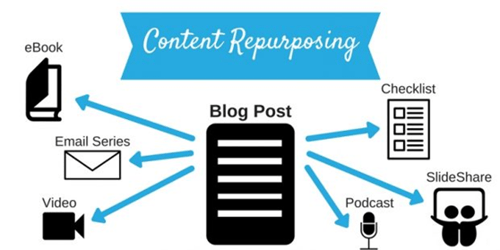
Repackaging content in this way allows you to meet the communication preferences of different people, ensuring you deliver the right content, to the right person, in their preferred format. For example, if you only make videos, then you can’t expect to educate, delight, and inspire folks who prefer to read blogs or articles and never consume video (and vice versa).
As an example, academics generally like to dive deep into the data (and they often use the information they gather to make their purchasing decisions). As such, they tend to prefer whitepapers and datasheets as these resources cater to their love of data (and aren’t often filled with marketing language). On the other hand, top-level summaries tend to resonate better with executives in CROs, big pharma, or biotech companies, as they are very time poor and this allows them to quickly determine whether your offering will help them meet their goals.
To understand the type of content that your audience likes to consume, it’s important to have as much intel as possible about the channels they prefer, the formats they engage with and the content they consume. This can be achieved by developing buyer personas driven by “real-life” customer insights, making it easier to create content that caters to their goals and frustrations, shared across channels they typically engage with. You can also use web and email marketing analytics tools to constantly assess which channels, content types and formats are performing the best (e.g. driving the most website visitors, increasing “time on site”, generating the most leads/engagement etc.), so that you can use this info to further hone your content strategy.
To this end, many CRM systems will help you segment your contact list based on certain activities like which web pages they visited and which emails they engaged with —meaning you can build up even more detailed, personalised buyer personas. Furthermore, you can always conduct research into your audience segments by sending questionnaires to your contact lists—perhaps you’ll discover that a subset of executives enjoys listening to podcasts on their morning commutes or runs?
Why repurpose your content?
Apart from the fact that people consume information in different ways and find content via a variety of channels, there are a number of other good reasons to repurpose your content, which we explore in more detail below.
Reason 1: The hard work is already done
Content forms the backbone of any inbound or content marketing strategy, as high-quality content is what attracts modern prospects and ultimately persuades them to take action. If you think of your prospect’s attention as a finite entity, then in an ever more-connected world, the competition for this resource is increasing.
Content that provides useful information, answers pressing questions and is targeted to a specific buyer persona is most likely to garner the attention of your target audiences. Creating such high-quality content is hard, but once you have it, repurposing it allows you to focus on getting the information into the hands of more people, without having to do as much extra work.
Reason 2: It makes it easier to publish content more regularly
Producing more content allows you to publish on your website, blog, social profiles and via your email marketing efforts more regularly. Consistently and regularly updating your customers and prospects in this way is an important way to maintain awareness and engagement.
How regular these updates need to be depends on the platform and the industry. For instance, HubSpot suggests that you need to be posting blogs at least 11 times per month to get the biggest upswing in web traffic.
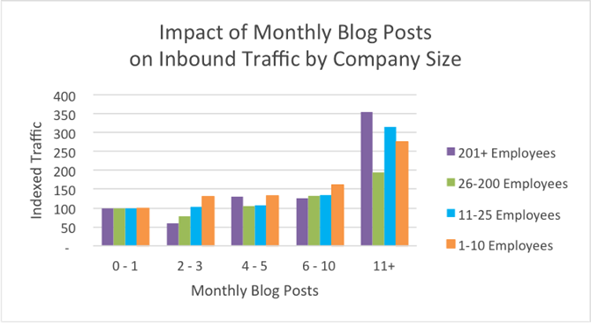
However, even posting one or two blog posts a month is a lot for many life science companies, depending on the writing skills and capacity they have available within the team. That’s a lot of content, and we understand just how difficult it can be to keep on top of lead generation, account management, social media management, and the numerous additional tasks a life science marketer needs to perform… without the additional concern of regularly writing blog posts too.
That’s why, if you’re running low on time, delving into your content archive to repurpose some content from a previous piece can be an ideal tactic.
Another approach the team at BioStrata typically uses is to create “modularised content”. The tactic is best illustrated by using an example: if we create an in-depth piece of content like an eBook or whitepaper, we will deliberately design it to be made up of multiple chapters, each approx. 500-1000 words each. In turn, these chapters can be quickly and easily repurposed into blog posts. As a bonus, the call to action at the bottom of each post is for readers to download the main whitepaper. In effect, each blog post acts a “teaser trailer” that delivers some value and insight, while making it clear that readers should download the main whitepaper to get the “full story”. You can then promote each blog post via email and a series of social media posts (giving you multiple opportunities to capture the attention of your target audience). Creating multiple posts on a single topic also helps with SEO and can draw in more traffic from search engines (as we’ll explore a bit more in the next section).
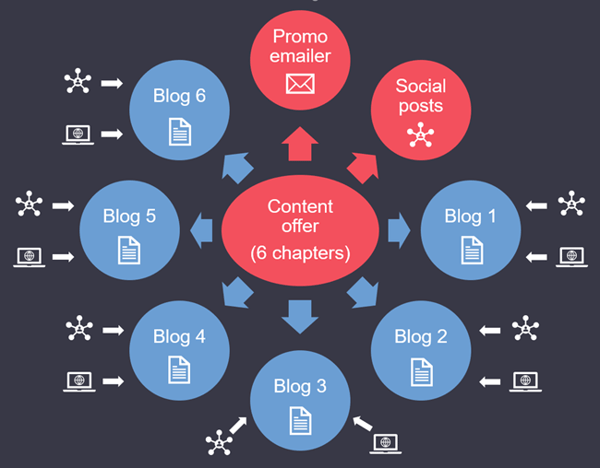
Reason 3: It can help improve the SEO of your website
High organic visibility is the white whale of inbound marketing. Everyone wants their site to occupy the top spot in organic search engine rankings and it’s worth aiming for the first page of search results, as organic visibility can have a dramatic impact on your ability to attract new prospects. It’s unsurprising then that making sure their brand continues to rank highly is an important goal for many life science companies.
Content repurposing can help with this. Creating keyword-rich content in different formats gives you multiple opportunities to rank on different search engines and in different locations online (think YouTube and social media channels etc.). Creating a series of blog posts on the same topic is also a good way of signalling to search engines that your website (and brand) can offer visitors valuable insights and information on that topic.
When repurposing content, it’s worth considering all the different key terms and phrases prospects might use when searching for problems and solutions related to your business (e.g. by conducting keyword research when setting your content strategy). These keywords can then be used repeatedly across those blog posts (especially in page headers and subheads) to give you an SEO boost.
Reason 4: You can engage prospects at different stages of their buyer’s journey
If you’ve created high-quality content (and even repurposed it for another audience’s communication preferences), then you may want to consider how useful that specific piece of content is for prospects at different stages of their buyer’s journeys.
A simplified overview of a typical buyer’s journey is the following: A prospect first becomes aware that they have a problem or opportunity, then considers and researches all possible solutions to that problem, before finally reaching a decision and making a purchase. The stages of the buyer’s journey dictate the customer’s frame-of-mind and influence how they search for content, as well as what content they are likely to find helpful. This in turn dictates the type of content you need to produce for prospects at different stages of that journey.
For instance, a lab user might be unaware of the impact a new FDA-enforced regulation will have on their work. They may need to purchase new equipment or services that comply with the new guidance, but they need to be made aware of the problem in the first place, as failure to comply with the guidance could affect their output. So, a relevant service or product provider would create content designed to educate them on what the FDA regulation is and how it will impact their work.
Next, the company would look to create consideration-stage content. Here, the goal is to educate the prospect about all the solutions available to them to bring them in line with the new regulation. Although it’s best practice to give an overview of all possible solutions (even those that are not provided by your company), one of the solutions will be purchasing equipment or services from you.
Finally, the prospect will enter the decision stage. For example, perhaps they will have decided to purchase equipment to comply with the new FDA ruling. In this case, your company will need to create content that describes the features and benefits of their solution. This will enable the prospect to determine if this solution is right for them, or if they need to look elsewhere.
You can repurpose your content to align with the messaging required at different stages of a prospect’s buyer’s journey. This will help them decide on whether your solution is right for them. Keeping the prospect’s needs in mind also positions you as a helpful, collaborative partner, which will help you forge meaningful relationships with your customers.
At the same time, some content formats tend to work especially well at certain stages of the buyer’s journey, as you can see in the graphic below.
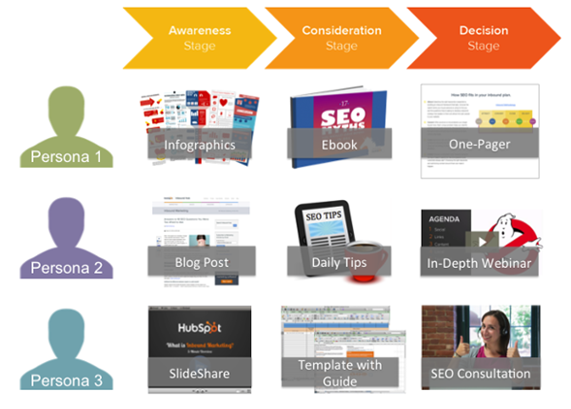
A side benefit of strategic content repurposing is that it helps ensure prospects and customers have a consistent experience with your brand. Building trust with your customers is a key principle of inbound marketing, and a consistent, smooth experience is likely to be perceived as more trustworthy than incoherent, disconnected messages.
Reason 5: Repetition drives memory and can help you gain authority in your industry
As the old business and communication adage goes, “People must hear something seven times before they really hear it for the first”. In this case, repetition is key to ensure people really hear and understand a message.
When it comes to marketing and advertising, this mindset is rooted in the “mere-exposure” effect, by which people show a preference for something if they are familiar with it. Research suggests that the effect has a maximum impact at somewhere between 10 and 20 exposures. Other sources of marketing wisdom put the number between anywhere from 7 to 20 exposure times. Regardless, if you want people to remember what you say and the content you create, then you need to repeat yourself often.
Repetition that leads to memory has another benefit: it establishes you as an authority in the minds of your audience. If your content continually educates and inspires your prospects with the latest breakthroughs and answers all their questions then this will help you to stand out from the crowd and position you as a thought-leader, educator and helpful expert—not just a vendor. How can you achieve this repetition without investing significant amounts of time, money and resources? All together now: REPURPOSE!
How to get started with content repurposing
Given all the benefits of repurposing, what are the fastest ways to get started?
Well, our team typically approaches repurposing in two ways—remixing a content piece into different formats or finding new ways to promote existing content via new channels. In reality, the line between the two can blur easily, especially if you repurpose content into a new form to better suit a given channel (e.g. repurpose an infographic into an animation in order to upload it to your YouTube channel).
In general, the first step we take is to look at our channel repurposing wheel (see below) to stimulate ideas for how we could get the most from an existing asset like a whitepaper or blog post by promoting and sharing it across a wider-range of channels:
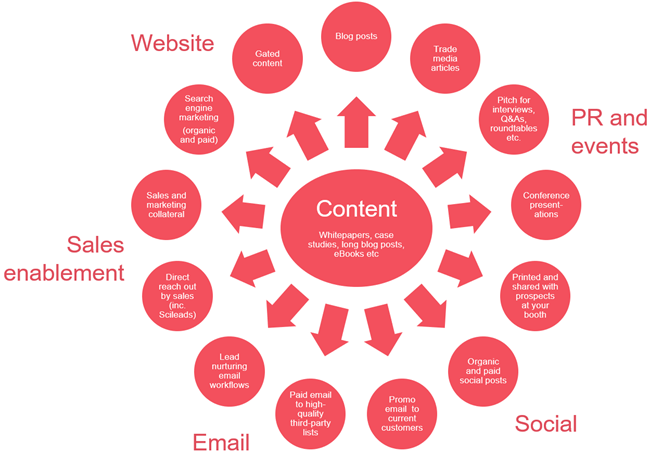
If we want to eke out even more value from a given piece, we’ll use our content repurposing wheel to generate new pieces of content from a central “pillar piece” of content:
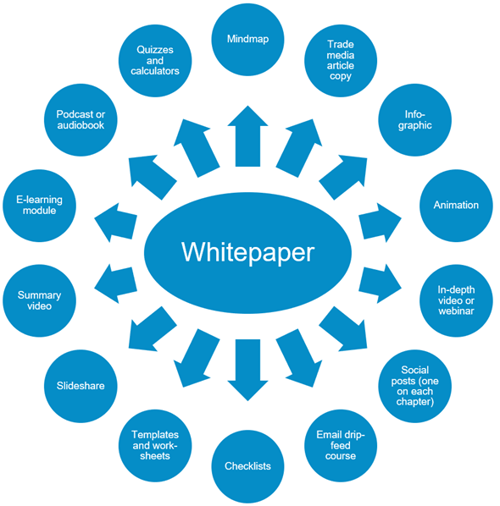
Using both these tools, it is possible to produce months (or even years) of content pieces based on only one or two high-value pieces of “pillar content”. However, please note, this pillar piece needs to be of high quality and depth, so that you can lift and remix different elements without creating new pieces that are too light on detail, substance, or insight. If you find that your new content is suffering from any of these weaknesses (or if you are starting to create pieces that are just too similar), then it’s time to close that repurposing project and create a new pillar piece (kick-starting the repurposing process once again).
Using content repurposing to boost the ROI of your life science marketing
Content repurposing allows you to increase the regularity of your updates, drive more engagement, expand your reach, and increase your organic visibility, all without having to over-invest in creating lots of content from scratch (which can take a lot of time and resources).
Collectively, these factors will help you gain authority on a given topic and become an industry thought leader. As you become the go to source for information in your industry, you’ll likely become the go to solution provider too—which will increase your sales.
Get more life science marketing insights
Want more great content like this delivered to your email inbox every month? Then sign up to our newsletter.





